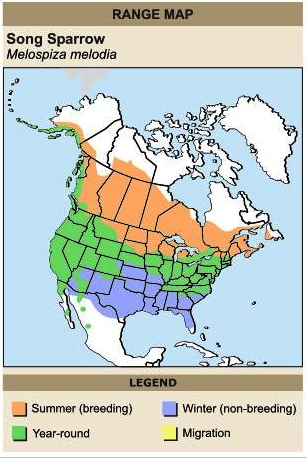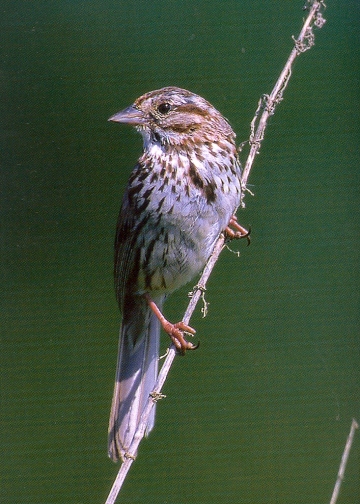|
Medium sparrow,
heavily streaked gray-brown upperparts. Dull white underparts have dark
central breast spot, thick streaks. Head has brown crown, paler median
stripe, pale gray eyebrow, white chin, dark brown moustache stripe.
Rust-brown wings. Tail is long, usually tinged rust-brown.

|
SONG
SPARROW
Melospiza melodia
PASSERIFORMES
Sparrows (Emberizidae)
Range and Habitat
Breeds from the Aleutians and mainland Alaska east to Newfoundland and
south to California, North Dakota, and Carolinas. Spends winters from
southern Canada throughout the U.S. to the Gulf Coast and Mexico. Preferred
habitats include forest edges, clearings, thickets, and marshes with
open grassy feeding areas; also found in undergrowth in gardens and
city parks.
SOUND: "Madge-Madge-Madge, put-on-your-tea-kettle-ettle-ettle"
The Song Sparrow lives up to its name, being one of the most persistent
singers throughout the spring and summer.
Other birds such as mockingbirds are not able to
effectively imitate their song.
They recognizes enemies by both instinctual and learned patterns, and
adjusts future behavior based on both its own experiences in encounters,
and from watching other birds interact with enemies.
A group of Song Sparrows are collectively known as a "flock",
"choir", and "chorus" of sparrows.
The Song Sparrow is a medium-sized bird which may be found in virtually
any habitat. However, preferred environments include brushlands and
freshwater and salt marshes throughout Canada and the United States.
These birds are also frequently found in areas of human inhabitation.
Northern populations migrate to the southern United States and Mexico
during winter months. Some specimens have been seen in Western Europe,
Great Britain and Norway. Food is found by foraging on the ground, in
shrubs or shallow water. Diets consist mainly of insects and seeds,
and possibly crustaceans.
The conservation rating of the Song Sparrow is Least Concern.

|